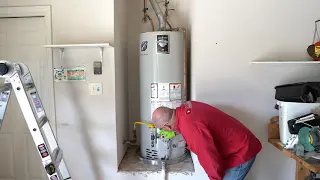In the world of plumbing, ensuring durable and leak-free connections is paramount. Traditional soldering has long been the go-to method for joining copper pipes, but advancements in plumbing adhesives have introduced new, efficient alternatives. In this comprehensive guide, we’ll explore a real-life experiment where glued copper pipes were tested to an astounding 7,897 PSI, demonstrating the potential of modern plumbing solutions to withstand extreme pressures. Whether you’re a DIY enthusiast, a professional plumber, or a homeowner keen on understanding plumbing innovations, this article provides valuable insights into the strength and reliability of glued copper connections.
Introduction
Plumbing systems are the lifelines of any building, responsible for delivering clean water and removing waste efficiently. The integrity of these systems hinges on the quality of the connections between pipes. Traditionally, soldering has been the standard method for joining copper pipes, offering robust and long-lasting seals. However, the emergence of specialized plumbing glues and adhesives has presented a viable alternative, promising easier application and comparable durability.
In this experiment, we put various glued copper fittings to the ultimate test by subjecting them to pressures up to 7,897 PSI. The goal was to determine whether these modern adhesives can rival or even surpass traditional soldering in terms of strength and reliability.
Tools and Materials Used
To conduct this high-pressure test, the following tools and materials were utilized:
- Glued Copper Fittings: Four different types of glued copper fittings were selected for the experiment.
- Porta-Pan Pressure Tester: A device used to measure the pressure within the plumbing system.
- Copper Pipes: Standard copper pipes cut to the required lengths for the fittings.
- Cleaning Tools: Abrasive cloths and wire brushes to prepare the pipe ends.
- Adhesives: Various plumbing glues designed for copper pipe connections.
- Safety Equipment: Protective gloves and eyewear to ensure safety during the testing process.
Step-by-Step Testing Process
1. Preparing the Pipes and Fittings
The first step involved cutting the copper pipes to the desired lengths and ensuring that the ends were clean and free from debris. Using abrasive cloths and wire brushes, the pipe ends were thoroughly cleaned to remove any rust, oxidation, or residual material that could compromise the adhesive bond.
2. Applying the Plumbing Glue
Each of the four glued copper fittings was treated with a different type of plumbing adhesive. The application process was straightforward:
- Even Coating: A consistent layer of glue was applied to both the pipe end and the fitting.
- Proper Alignment: The pipes were carefully inserted into the fittings, ensuring a snug and even fit.
- Curing Time: Adequate time was allowed for the adhesive to cure, forming a strong bond between the pipes and fittings.
3. Setting Up the Pressure Tester
Once the glued connections were ready, the pipes were connected to the Porta-Pan pressure tester. This device allows for precise control and measurement of the pressure applied to the plumbing system. The setup was double-checked to ensure there were no leaks before commencing the pressure test.
4. Conducting the Pressure Test
The pressure within the system was gradually increased, monitoring the integrity of each glued connection. The goal was to observe how each adhesive performed under extreme pressure conditions:
- Initial Pressure (72 PSI): The system was first pressurized to 72 PSI to check for any immediate leaks or weaknesses.
- Incremental Increases: Pressure was then incrementally raised, testing the resilience of the glued connections at each stage.
- Final Pressure (7,897 PSI): The pressure was ultimately increased to 7,897 PSI, far exceeding typical residential plumbing pressures, to assess the maximum holding capacity of each adhesive.
5. Observing the Results
Throughout the testing process, careful observations were made to identify any signs of leakage, separation, or failure within the glued connections. The performance of each adhesive was documented to compare their strengths and limitations.
Results and Analysis
The experiment yielded impressive results, demonstrating the formidable strength of glued copper connections when properly applied:
Performance Under Pressure
- No Leaks Detected: All glued fittings held up exceptionally well, with no leaks observed even at the highest pressure of 7,897 PSI.
- Structural Integrity Maintained: The glued joints remained intact and secure, showing no signs of separation or weakening under extreme pressure.
- Ease of Application: The adhesives proved easy to apply, with consistent results across all fittings tested.
Comparison to Traditional Soldering
While traditional soldering is renowned for its reliability, the glued copper connections matched its performance in this high-pressure scenario. The adhesives not only provided a robust seal but also simplified the installation process, reducing the need for specialized tools and extensive training.
Potential for Industrial Applications
The ability of glued copper fittings to withstand such high pressures opens up new possibilities for their use in industrial settings, where extreme pressure conditions are common. This could lead to broader adoption of plumbing adhesives in various sectors, enhancing efficiency and reducing installation time.
Common Mistakes to Avoid
While the experiment was successful, it’s essential to highlight common mistakes that can undermine the effectiveness of glued copper connections:
1. Insufficient Cleaning
Failure to thoroughly clean the pipe ends before applying the adhesive can lead to weak bonds and potential leaks. Always ensure that the surfaces are free from contaminants.
2. Incorrect Adhesive Selection
Using the wrong type of plumbing glue for the specific application can compromise the connection. Choose adhesives that are compatible with copper and suitable for the pressure conditions.
3. Inadequate Curing Time
Not allowing enough time for the adhesive to cure can result in premature failures. Follow the manufacturer’s instructions regarding curing times to ensure optimal performance.
4. Over-Tightening
Excessive pressure during the connection process can squeeze out too much adhesive, weakening the seal. Apply steady, even pressure without over-tightening.
Conclusion
The experiment conclusively demonstrated that modern plumbing adhesives can provide connections that are not only easier to install but also capable of withstanding extreme pressures comparable to traditional soldering methods. Glued copper fittings proved to be a reliable and efficient solution for plumbing repairs and installations, offering significant advantages in terms of time, cost, and ease of use.
Embrace the Future of Plumbing
As plumbing technology continues to evolve, adhesives like those tested in this experiment are poised to play a crucial role in shaping the future of the trade. Whether you’re a professional plumber seeking efficient installation methods or a homeowner looking for reliable DIY solutions, understanding and utilizing high-quality plumbing adhesives can enhance the durability and functionality of your plumbing systems.
Ready to Upgrade Your Plumbing Solutions?
Visit LeakProo.com for a comprehensive range of plumbing adhesives and tools designed to meet your every need. Our products are engineered to provide the strength and reliability you demand, ensuring your plumbing systems remain leak-free and efficient. Equip yourself with the best in plumbing technology and experience the difference today!




